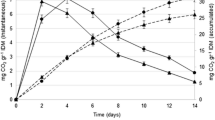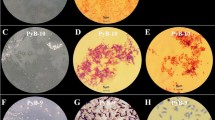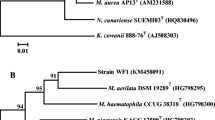Abstract
Pyrene and fluoranthene, when supplied as the sole carbon source, were not degraded by Burkholderia sp. VUN10013. However, when added in a mixture with phenanthrene, both pyrene and fluoranthene were degraded in liquid broth and soil. The amounts of pyrene and fluoranthene in liquid media (initial concentrations of 50 mg l−1 each) decreased to 42.1% and 41.1%, respectively, after 21 days. The amounts of pyrene and fluoranthene in soil (initial concentrations of 75 mg kg−1 dry soil each) decreased to 25.8% and 12.1%, respectively, after 60 days. None of the high molecular weight (HMW) polycylic aromatic hydrocarbons (PAHs) tested adversely affected phenanthrene degradation by this bacterial strain and the amount of phenanthrene decreased rapidly within 3 and 15 days of incubation in liquid broth and soil, respectively. Anthracene also stimulated the degradation of pyrene or fluoranthene by Burkholderia sp. VUN10013, but to a lesser extent than phenanthrene. The extent of anthracene degradation decreased in the presence of these HMW PAHs.




Similar content being viewed by others
References
Bouchez M, Blanchet D, Veronique B, Haeseler F, Vandecasteele J-P (1999) Efficiency of defined strains and of soil consortia in the biodegradation of polycyclic aromatic hydrocarbon (PAH) mixtures. Biodegradation 10:429–435
Boonchan S, Britz ML, Stanley GA (1998) Surfactant-enhanced biodegradation of high molecular weight polycyclic aromatic hydrocarbons by Stenotrophomonas maltophiia. Biotechnol Bioeng 59:481–494
Boonchan S (2000) Biodegradation of polycyclic aromatic hydrocarbons: application of fungal–bacterial co-cultures and surfactants. Doctoral dissertation, Environmental Microbiology. Centre for Bioprocessing and Food Technology. Victoria University of Technology
Chen S, Aitken MD (1999) Salicylate stimulates the degradation of high-molecular weight polycyclic aromatic hydrocarbons by Pseudomonas saccharophila P15. Environ Sci Technol 33:435–439
Dean-Ross D, Moody J, Cerniglia CE (2002) Utilization of mixtures of polycyclic aromatic hydrocarbons by bacteria isolated from contaminated sediment. FEMS Microbiol Ecol 41:1–7
EPA (1992) Soxhlet extraction of nonvolatile and semivolatile organics from solids (method 3540B). In EPA methods:1–8
Goldsten RM, Mallory LM, Alexander M (1985) Reasons for possible failure of inoculation to enhance biodegradation. Appl Environ Microbiol 50:977–983
Heitkamp MA, Freeman JP, Cerniglia CE (1987) Naphthalene biodegradation in environmental microcosms: estimates of degradation rates and characterization of metabolites. Appl Environ Microbiol 53:129–136
Herwijnen R, Wattiau P, Bastiaens L, Daal L, Jonker L, Springeal D, Govers HAJ, Parsons JR (2003) Elucidation of the metablic pathway of fluorene and cometabolic pathways of phenanthrene, fluoranthene, anthracene and dibenzothiophene by Sphingomonas sp. LB126. Res Microbiol 154:199–206
Ho Y, Jackson M, Yang Y, Mueller JG, Pritchard PH (2000) Characterization of fluoranthene- and pyrene-degrading bacteria from PAH-contaminated soils and sediments. J Ind Microbiol Biotechnol 24: 100–112
Juhasz AL, Britz ML, Stanley GA (1997) Degradation of fluoranthrene, pyrene, benz[a]anthracene by Burkholderia cepacia. J Appl Microbiol 83:189–198
Kästner M, Breuer-Jammali M, Mahro B (1998) Impact of inoculation protocols, salinity, and pH on the degradation of polycyclic aromatic hydrocarbons (PAHs) and survival of PAH-degrading bacteria introduced into soil. Appl Environ Microbiol 64:359–362
Leblond JD, Schultz TW, Sayler GS (2001) Observations on the preferential biodegradation of selected components of polyaromatic hydrocarbon mixtures. Chemosphere 42:333–343
Margesin R, Schinner F (1997) Efficiency of indigenous and inoculated cold-adapted soil microorganisms for biodegradation of diesel oil in alpine soils. Appl Environ Microbiol 63:2660–2664
McLellan SL, Warshawsky D, Shann JR (2002) The effect of polycyclic aromatic hydrocarbons on the degradation of benzo[a]pyrene by Mycobacterium sp. strain RGJII-135. Environ Toxicol Chem 21:253–259
McNally DL, Mihelcic JR, Lueking DR, (1999) Biodegradation of mixtures of polycyclic aromatic hydrocarbons under aerobic and nitrate-reducing conditions. Chemosphere 38:1313–1321
Nuttapun S, Pinphanichakarn P, Pattaragulwanit K, Thaniyavarn S, Omori T, Juntongjin K (2001) Isolation and characterization of a phenanthrene-degrading Sphingomonas sp. strain P2 and its ability to degrade fluoranthene and pyrene via co-metabolism. Sci Asia 27:21–28
Providenti MA, Lee H, Trevors JT (1993) Selected factors limiting the microbial degradation of recalcitrant compounds. J Ind Microbiol 12:379–395
Rehmann K, Noll H, Steinberg C, Kettrup A (1998) Pyrene degradation by Mycobacterium sp. strain KR2. Chemosphere 36:2977–2992
Wattiau P (2002) Microbial aspects in bioremediation of soils polluted by polyaromatic hydrocarbons. In: Agathos SN, Reineke W (eds) Biotechnology for the environment: stategy and fundamentals. Focus on biotechnology Series, Vol 3A. Klüwer Academic Publishers, Dordrecht, pp 1–22
Acknowledgements
We acknowledge the financial support from the Thailand Research Fund through the Royal Golden Jubilee Ph.D. Program (Grant No. PHD/0127/2545) to student (Khanitta Somtrakoon) and advisor (Suchart Upatham). We thank the Post-Graduate Education, Training and Research Program in Environmental Science, Technology and Management for the permission to use GC-MS instrument, and the Land Development Regional Office 2 (Chonburi, Thailand) for soil analysis.
Author information
Authors and Affiliations
Corresponding authors
Rights and permissions
About this article
Cite this article
Somtrakoon, K., Suanjit, S., Pokethitiyook, P. et al. Phenanthrene stimulates the degradation of pyrene and fluoranthene by Burkholderia sp. VUN10013. World J Microbiol Biotechnol 24, 523–531 (2008). https://doi.org/10.1007/s11274-007-9503-7
Received:
Accepted:
Published:
Issue Date:
DOI: https://doi.org/10.1007/s11274-007-9503-7




